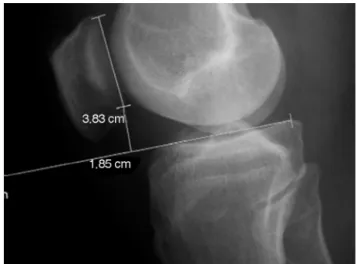w w w . r b o . o r g . b r
Original
Article
Comparative
evaluation
of
patellar
height
methods
in
the
Brazilian
population
夽
Christian
Behrendt,
Alexandre
Zaluski,
Rodrigo
Pires
e
Albuquerque
∗,
Eduardo
Branco
de
Sousa,
Naasson
Cavanellas
InstitutoNacionaldeTraumatologiaeOrtopedia,RiodeJaneiro,RJ,Brazila
r
t
i
c
l
e
i
n
f
o
Articlehistory:
Received14January2015 Accepted19February2015 Availableonline29December2015
Keywords:
Patella Radiology Knee
a
b
s
t
r
a
c
t
Objective:Themethodsmostusedforpatellarheightmeasurementwerecomparedwith theplateau–patellaanglemethod.
Methods:A cross-sectionalstudy was conducted, in which lateral-view radiographs of the kneewereevaluated usingthethreemethodsalready establishedin theliterature: Insall–Salvati(IS),Blackburne–Peel(BP)andCaton–Deschamps(CD).Thesewerecompared withtheplateau–patella anglemethod.Onehundredandninety-sixrandomlyselected patientswereincludedinthesample.
Results:The data wereinitially evaluated using the chi-square test. Thisanalysis was deemed to bepositive withp<0.0001. We compared the traditionalmethodswith the plateau–patellaanglemeasurement,usingFisher’sexacttest.IncomparingtheISindexwith theplateau–patellaangle,wedidnotfindanystatisticallysignificantdifferencesinrelation totheproportionofalteredcasesbetweenthetwogroups.Thetraditionalmethodswere comparedwiththeplateau–patellaanglewithregardtotheproportionsofcasesofhighand lowpatella,bymeansofFisher’sexacttest.Thisanalysisshowedthattheplateau–patella angleidentifiedfewercasesofhighpatellathandidtheIS,BPandCDmethods,butmore casesoflowpatella.Incomparingpairs,wefoundthattheISandCDindiceswerecapable ofidentifyingmorecasesofhighpatellathanwastheplateau–patellaangle.Inrelationto thecasesoflowpatella,theplateau–patellaanglewascapableofidentifyingmorecases thanweretheotherthreemethods.
Conclusions: Theplateau–patellaanglefoundmorepatientswithlowpatellathandidthe classicalmethodsandshowedresultsthatdivergedfromthoseoftheotherindicesstudied. ©2015SociedadeBrasileiradeOrtopediaeTraumatologia.PublishedbyElsevierEditora Ltda.Allrightsreserved.
夽
WorkdevelopedintheDepartmentofOrthopedicsandTraumatology,InstitutoNacionaldeTraumatologiaeOrtopedia,RiodeJaneiro, RJ,Brazil.
∗ Correspondingauthor.
E-mail:rodalbuquerque19@gmail.com(R.P.eAlbuquerque).
http://dx.doi.org/10.1016/j.rboe.2015.12.007
relac¸ãoàproporc¸ãodecasosalteradosentreosdoisgrupos.Osmétodostradicionaisforam comparadoscomamedidadoAPPquantoàproporc¸ãodecasosdepatelaaltaebaixapelo testeexatodeFisher.AanálisedemonstrouqueoAPPidentificoumenoscasosdepatela altadoqueosmétodosdeIS,BPeCD,masidentificoumaiscasosdepatelabaixa.Quando comparadosospares,verificamosqueosíndicesdeISeCDforamcapazesdeidentificar maiscasosdepatelaaltaqueoAPP.Emrelac¸ãoaoscasosdepatelabaixa,oAPPfoicapaz deidentificarmaiscasosqueosoutrostrêsmétodos.
Conclusão:Oânguloplatô-patelaobservoumaispacientescompatelabaixaemcomparac¸ão comosmétodosclássicoseresultadosdiscrepantescomosoutrosíndicesestudados.
©2015SociedadeBrasileiradeOrtopediaeTraumatologia.PublicadoporElsevier EditoraLtda.Todososdireitosreservados.
Introduction
Patellar heightmeasurement is increasingly being used as knowledgeofkneebiomechanicsandthephysiopathologyof kneediseasesandtheirrespectivetreatmentsexpands.1
Over the course of time, a variety of methods have beenproposedasmeansofdefiningtheconceptofpatellar kneemeasurement,usuallythroughratiosbetween anatom-ical parameters obtained from radiographic examinations. Several indexes have become established in the litera-ture, suchas Insall–Salvati(IS),2 Blackburne–Peel (BP)3 and Caton–Deschamps(CD),4butnoneofthemhaveyetachieved worldwideacceptance.
Theplateau–patellaangleisanoptionalmethodfor eval-uatingpatellarheightthat,unlikethemethodsestablishedin theliterature,doesnotusecalculationofratiosandsupplies whole-numbervalues.Itisthereforesimpler,fasterandmore practical.5
The objective of this study was to compare the meth-ods most used for measuring patellar height2–4 with the plateau–patellaanglemethod.5
Materials
and
methods
Thisstudy was assessedand approvedbyour institution’s ethicscommittee.
A cross-sectional study was conducted in which radio-graphsproducedattheNationalInstituteofTraumatologyand Orthopedics(INTO)wereevaluatedusingthethreemethods thathavebecomeestablishedintheliterature:Insall–Salvati
(IS),2 Blackburne–Peel (BP)3 and Caton–Deschamps (CD).4 Thesewerecomparedwiththeplateau–patellaangle.5
Thesamplecomprised196patients attheKneeSurgery CenteroftheNationalInstituteofTraumatologyand Ortho-pedics,whowererandomlyselected.Thepatientsincludedin thestudyhadundergonekneeradiographybetweenJanuary 2013andApril2014,consistingatleastoftheanteroposterior (AP)viewunderweight-bearingatfullkneeextensionandin lateralviewwithoutweight-bearinginasemiflexedposition (30◦).Patientswithosteoarthrosisorinflammatoryarthritis and thosewho had hadprevious fracturesor surgerywere excludedfromthestudy.
Allthepatientsunderwentradiographicexaminationsin accordancewiththeroutineestablishedbyourinstitution.A Shimatzu500mAX-raymachinewasused,at50kVand25mA. Afilmofdimensions30cm×40cmwasplacedatadistance ofone meterfrom the ampouleofthe digitalradiographic machine.Theimagesforthisstudywerethenobtained.
The radiographs were evaluated bya physicianwho is a member of the Brazilian Society of Knee Surgery and hasadoctoraldegree,inordertoensurethereproducibility andreliabilityofthemeasurementsobtained.These evalua-tionsweremadethroughtheMDViewer2000®software,which enablesprecisedigitalmeasurementsinrelationto anatomi-calparametersthatareeasilyidentifiableandhavepreviously beenestablishedintheliterature,andminimizesthe evalua-tor’sinfluenceinobtainingthemeasurements.
Fig.1–Lateral-viewradiographoftheknee.Insall–Salvati calculation.
patella toits insertion inthe tibial tubercle,and PL isthe greatestdiagonallengthofthepatella.Normalvaluesrange from0.8to1.2.2
TheBlackburne–Peelindex3 consistsofthe ratio H/B, in whichHistheperpendicularheightfromthedistalpartof thejointsurfaceofthepatellatoalineprojectedanteriorly fromthesurfaceofthetibialplateauandBisthelengthofthe jointsurfaceofthepatella.Thevaluesthatareconsideredto benormalrangefrom0.54to1.06.
TheCaton–DeschampsindexconsistsoftheratioTJ/PJ,in whichTJisthedistancefromtheloweredgeofthejoint sur-faceofthepatellatotheanterosuperiorangleofthetibiaand PJisthelengthofthepatellarjointsurface.Thepatellarheight isconsideredtobenormalwithvaluesrangingfrom0.6to1.2.4 Theplateau–patellaangle,i.e.theparameterinquestion here,isformedbyalinethatistangentialtothemedialtibial plateauandasecondlinethatconnectstheloweredgeofthe tibialplateautothelowermarginofthepatellarjointsurface, onlateral-viewradiographswiththekneeflexedat30◦.The angularvaluesthatareconsideredtobenormalrangefrom 21◦ to29◦.Valueslowerthan21◦definealowpatella,while valuesgreaterthan29◦indicateahighpatella.5
Measurements of the three indexes: Insall–Salvati (IS)2 (Fig.1),Blackburne–Peel(BP)3(Fig.2)andCaton–Deschamps (CD)4(Fig.3),weremadeoneachoftheradiographsselected, alongwiththeplateau–patellarangle5(Fig.4).
The data were tabulated in a Microsoft Excel spread-sheetforanalysisand were then presentedinthe formof mean+standarddeviation.Findingswithpvalueslessthan orequalto0.05wereconsideredtobesignificant.The statis-ticalanalysiswasperformedusingthechi-squareandFisher exacttests,intheGraphPad5softwareforWindows.
Results
Atotalof196radiographsofpatientsattheKneeSurgery Cen-terofINTOwhowerebeingfollowedupbetweenJanuary2013 andApril2014wereincludedinthisstudy,takingtheinclusion andexclusioncriteriaintoconsideration.
Fig.2–Lateral-viewradiographoftheknee. Blackburne–Peelcalculation.
Fig.3–Lateral-viewradiographoftheknee. Caton–Deschampscalculation.
statisticalsignificanceexistedwithinthesample.This anal-ysiswaspositive,withp<0.0001.
Thedatawere then groupedas altered,referring tothe sumofcasesoflowandhigh patella,and ascases consid-eredtobenon-altered.Table2summarizestheresultsfrom thisanalysis.
Onceagain,anoverallanalysiswasperformed,inorderto identifysignificantdatapairs,whichshowedp<0.0029.
Fromthisanalysis,comparisonsweremadebetweenthe traditional methods and plateau–patellar angle measure-ments,usingFisher’sexacttest.
In comparing the Insall–Salvati (IS) index with the plateau–patellar angle (PPA), we did not find any statisti-callysignificantdifferencesinrelationtotheproportionsof alteredcasesinthe twogroups(IS164vs.PPA157,p=NS). However, the PPA was capable of identifying morealtered casesthanweretheBlackburne–PeelandCaton–Deschamps indexes,respectively(PPA39vs.BP15,p=0.0006;andPPA39 vs.CD23,p=0.0373).
Thedatawerealsocomparedwithregardonlyto identi-ficationofcasesofhighandlowpatella,assummarizedin
Table3.
Thetraditionalmethodswerecomparedwiththe plateau-plateanglemeasurementsregardingtheproportionsofcases ofhighandlowpatella,usingFisher’sexacttest.
TheanalysisshowedthatthePPAidentifiedfewercasesof highpatellathandidtheIS,BPandCDmethods(PPA6vs.IS 24,BP13andCD23;p<0.0001),butidentifiedmorecasesof lowpatella(PPA33vs.IS8,BP2andCD0;p≤0.0001).
Table2–Distributionofthealteredandnormalcases accordingtothedifferentmethods.
IS BP CD PPA
Altered 32 15 23 39 Non-altered 164 181 173 157
Table3–Distributionofthealteredcasesaccordingto thediagnosesofhighandlowpatella.
IS BP CD PPA
Highpatella 24 13 23 6 Lowpatella 8 2 0 33
normalpatellarheight.
IS BP CD PPA
Lowpatella 8 2 0 33 Normalpatellarheight 164 181 173 157
Lastly,comparisonsbetweentheproportionsofcasesof
normalpatellarheightandthoseofhighpatella(Table4)and lowpatella(Table5)weremade.
Incomparingthepairs,wefoundthattheInsall–Salvatiand Caton–Deschampsindexeswerecapableofidentifyingmore casesofhighpatellathanwastheplateau–patellarangle(IS 24vs.PPA6,p=0.0034;andCD23vs.PPA6,p=0.059).
Inrelationtothecasesoflowpatella,theplateau–patellar anglewas capableofidentifyingmorecasesthanwere the otherthreemethods(PPA33vs.IS8,p=0.0001;PPA33vs.BP 2,p<0.0001;andPPA33vs.CD0,p<0.0001).Furthermore,the Insall–Salvatiindexidentifiedahigherproportionofcasesof lowpatellathandidtheCaton–Deschampsindex(IS8vs.CD 0,p=0.0035).
Discussion
Thelack ofanidealmethodfor measuringpatellarheight has made this a relevant and pertinent topic.Analysis on patellar height is of fundamental importance for patients withpatellofemoralcomplaints,andafteroperations involv-ingkneearthroplasty,reconstructionoftheanteriorcruciate ligamentorproximaltibialosteotomy.Forthisreason,thereis aneedforstudiesthatattempttovalidateasimpleand repro-duciblemeasurementmethod.PortnerandPakzad5reported that because the plateau and patella generate an anglein whichthenormalrangeisbetween21◦and29◦,thispresents an advantage in measurements, in comparison with the classical indexes.Thesetraditionalmethodsgenerate mea-surementsthatnecessitatecalculationsofproportions.5
dosesrequiredfordigitalradiographyarelower:thedoseis adjustedsothattheimagehasanappropriatesignal-to-noise ratioandtheradiationabsorbedbythepatientisdiminished.1 Ourthinkingisthatwithdigitalimages,themeasurements oftheanatomicalpointsthroughthesoftwarebecomemore precise.
Inour study,weusedlateral-viewradiographs withthe knee flexedat30◦, without weight-bearing,because this is a standardized examination in our hospital and in order toreproducetheoriginaldescriptionoftheplateau–patellar angle.Insall–Salvati2reportedthatifthekneewaspositioned withflexionof20◦,thiswouldgeneratetensioninthepatellar tendon.Ourthinkingisinlinewiththeirstatement,sincewe believethatradiographsproducedunderweight-bearing con-ditions,evenwiththekneeflexed,maygiverisetoimprecise positioningofthepatella.Seyahietal.6drewattentiontothe importanceofthedegreeofkneeflexioninproducing radio-graphsandsubsequentmeasurements.Intheirstudy,several radiographswereexcludedduetoinadequateflexion.6Forthis reason,theradiographsusedinourstudywereallproduced byasingleradiologytechnician,inordertoattempttoreduce thebias.
Ellingtonetal.7validatedthePPAincomparisonwiththe classicalindexes,inpatientswithkneeosteoarthrosis.Inour study,wechosetoexcludethesepatients,sinceinfrapatellar osteophytesandthoseintheintheanteriorregionofthetibial jointsurfacemighthavegeneratedincorrectmeasurements.
In a study conducted in Brazil by Gracitelli et al.,1 in whichpatellarheightmeasurementswerecompared,itwas observedthattheobserver’sexperiencehadaninfluencein analysesonthereproducibilityofthemeasurements.Thus, weused anobservedwith greatexperience inusingthese patellarindexesandalsowedidnotstipulatearesponsetime, inordertoattempttoreproducetheevaluationswithgreater precision.Seiletal.8statedthatpatellarheightclassification wasextremelydependentonthe examiner,andwe corrob-orateandbackthispointofview.Forthisreason,wedidnot conductanyinterobserveranalysis,inordertoattemptto vali-datethePPAmethodinrelationtotheclassicalmethods.
In a study on the patellar height index, Seyahi et al.6 foundpoorconcordanceandweakcorrelationincomparing themeasurements. Inour study,weobservedadiscrepant number of patients with low patella when we used the plateau–patellarangle. Seilet al.8 reportedthat the results betweenthe different indexeswere contradictoryand that theclassificationofhighpatellawoulddependonthemethod chosen.Seyahietal.6 statedthatthemethodsevaluatedin otherstudieshadbeenconsistentbutthattheiraccuracyhad notbeen informed.Ellington etal.7 concludedthat further studiesontheplateauandpatellaneededtobeconductedand thattheclinicalsignificanceoffindingsofhighorlowpatella neededtobecorrelatedwiththesemeasurements,with inves-tigationofhowthesemeasurementsrelatedtotheclassical methods.Inthisregard,weobservedthatthistopicrequired furtherexploration.Futurestudiesshouldbedevelopedwith theaimofgeneralizinganexistingmeasurementmethodfor highpatella,orperhapswiththeaimofcreatinganewindex. Weconsiderthat thestrong point ofour study wasthe fact that this was the first to make an evaluation of the
plateau–patellarangleamongBrazilians.TheBrazilian popu-lationpresentsgreatmiscegenation,suchthatitisimportant toascertainvariationsinindexesthatarepeculiartoour pop-ulation.
AccordingtoPena,9withthemiscegenationofthe Brazil-ianpopulation,theterm“race”oughttobebannedfromour dictionary.Itwasnotedinthisauthor’sstudythatthe propor-tionofAfricanancestryamongwhitesinsoutheasternBrazil was32%,whiletheproportionofEuropeanancestryamong blacksinthesameregionreached49%.9Becauseofthis,our studybecomesrelevant,sincethevaluesofourindexesmay notbereproducible,incomparisonwithotherpopulations.
In our study, there was no intention to make clinical correlations between different patellar height assessment methods.Felicioetal.10demonstratedrecentlythatpatellar heightwasnotassociatedwithpatellofemoralpainsyndrome. Thus,ourobjectivewasonlytomakecomparisonsbetween themethodstraditionallyusedandtheplateau–patellarangle.
Conclusion
Through the plateau–patellar angle method, morepatients withlowpatellawereobservedthanwhentheclassical meth-odswereused.Itproducedresultsthatwerediscrepantwith thosefromtheotherindexesstudied.
Conflicts
of
interest
Theauthorsdeclarenoconflictsofinterest.
r
e
f
e
r
e
n
c
e
s
1.GracitelliGC,PieramiR,TonelliTA,FaloticoGG,SilvaSD, NakamaGY,etal.Avaliac¸ãodosmétodosdemensurac¸ãoda alturapatelarnaradiografiadigital.RevBrasOrtop. 2012;47(2):210–3.
2.InsallJ,SalvatiE.Patellapositioninthenormalkneejoint. Radiology.1971;101(1):101–4.
3.BlackburneJS,PeelTE.Anewmethodofmeasuringpatellar height.JBoneJointSurgBr.1977;59(2):241–2.
4.CatonJ,DeschampsG,ChambatP,LeratJL,DejourH.Patella infera.Aproposof128cases.RevChirOrthopReparatrice ApparMot.1982;68(5):317–25.
5.PortnerO,PakzadH.Theevaluationofpatellarheight:a simplemethod.JBoneJointSurgAm.2011;93(1):73–80.
6.SeyahiA,AtalarAC,KoyuncuLO,CinarBM,DemirhanM. Blumensaatlineandpatellarheight.ActaOrthopTraumatol Turc.2006;40(3):240–7.
7.EllingtonM,RobinB,JupiterD,AllenB.Plateau-patellaangle inevaluationofpatellarheightinosteoarthritis.Knee. 2014;21(3):699–702.
8.SeilR,MullerB,GeorgT,KohnD,RuppS.Reliabilityand interobservervariabilityinradiologicalpatellarheightratios. KneeSurgSportsTraumatolArthrosc.2000;8(4):231–6.
9.PenaSDJ.Razõesparabaniroconceitoderac¸adamedicina brasileira.História,CiênciaeSaúde-Manguinhos.
2005;12(1):321–46.

